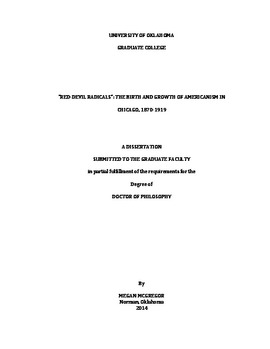| dc.contributor.advisor | Keppel, Ben | |
| dc.contributor.author | McGregor, Megan | |
| dc.date.accessioned | 2014-05-08T19:41:11Z | |
| dc.date.available | 2014-05-08T19:41:11Z | |
| dc.date.issued | 2014-05 | |
| dc.identifier.uri | https://hdl.handle.net/11244/10376 | |
| dc.description.abstract | In the midst of the struggle to reunite and reconstruct the nation following the Civil War, citizens of the United States also began to renegotiate what it meant to truly be an American. As the nation attempted to recover from this destructive and deadly war, some Americans found new sources of fear. While appeals to race hatred outlived the war, many people on both sides of the conflict looked with apprehension at the waves of immigrants coming to work in the industrializing nation. The leaders prominent in this historical account were searching for a unity that would paper-over rather than resolve differences over slavery and fundamental questions of human rights which now flowed from its demise. These Americans ventured to define that which could now be rendered politically “unthinkable” as simultaneously “Un-American.” Beginning in the 1870s, this term takes on a new meaning and significance that will last well into the twentieth century, as un-American is inextricably linked to the terms radical, socialist, or communist. The ways in which some Americans chose to react to events such as the Paris Commune in 1871, railroad strikes and general strikes in 1877, and the Haymarket affair in 1886, was used to create a new nationalism in the United States. “Americanism” was conceived in opposition to the Paris Commune and was consistently developed and applied to fight against organized labor and various political ideologies from 1871 to 1919. By the end of the First World War, “Americanism” had become institutionalized through national and legislation. This study examines that process of ideological invention and institutionalization at exceptionally close range by looking at its origins and trajectory in the heartland city of American industrialism, Chicago. From this local knowledge we gain the keys to a larger story: how an enduring and politically reactionary form of nationalism known still as “Americanism” came to be. | en_US |
| dc.language | en_US | en_US |
| dc.subject | History, United States. | en_US |
| dc.title | "Red Devil Radicals": The Birth and Growth of Americanism in Chicago, 1870-1919 | en_US |
| dc.contributor.committeeMember | Anderson, Gary | |
| dc.contributor.committeeMember | Chappell, David | |
| dc.contributor.committeeMember | Stockdale, Melissa | |
| dc.contributor.committeeMember | Zeigler, James | |
| dc.date.manuscript | 2014-05 | |
| dc.thesis.degree | Ph.D. | en_US |
| ou.group | College of Arts and Sciences::Department of History | |
